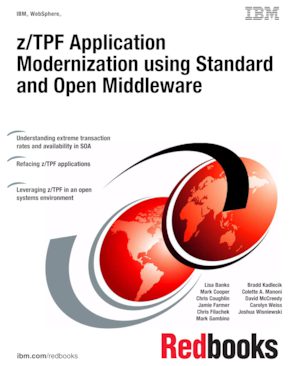About cookies on this site Our websites require some cookies to function properly (required). In addition, other cookies may be used with your consent to analyze site usage, improve the user experience and for advertising. For more information, please review your options. By visiting our website, you agree to our processing of information as described in IBM’sprivacy statement. To provide a smooth navigation, your cookie preferences will be shared across the IBM web domains listed here.

Published on 28 June 2013
Read in Google Books
Share this page:
ISBN-10: 0738438200
ISBN-13: 9780738438207
IBM Form #: SG24-8124-00
Authors: Dianne Lisa Banks, Mark Cooper, Chris Coughlin, Jamie Farmer, Chris Filachek, Mark Gambino, Bradd Kadlecik, Colette A. Manoni, David McCreedy, Carolyn Weiss and Josh Wisniewski
Abstract
In a world where product lifespans are often measured in months, the IBM® Transaction Processing Facility has remained relevant for more than four decades by continuing to process high volumes of transactions quickly and reliably. As the title of this book suggests, the z/TPF system uses open, standard interfaces to create services. Integration of new applications with existing z/TPF functions is a key factor in extending application capabilities. The ability for service data objects (SDO) to access the z/TPF Database Facility (z/TPFDF) provides a framework for data application program development that includes an architecture and application programming interfaces (APIs). SDO access to z/TPFDF provides remote client applications with access to z/TPF traditional data.
In the simplest terms, service-oriented architecture (SOA) is a means by which like, or unlike, systems can communicate with one another despite differences between each system's heritage. SOA can neutralize the differences between systems so that they understand one another. SOA support for z/TPF is a means by which z/TPF can interact with other systems that also support SOA. This book discusses various aspects of SOA in the z/TPF system, including explanations and examples to help z/TPF users implement SOA. IBM WebSphere® Application Server was chosen as the partner system as a means of demonstrating how a world class transaction server and a world class application server can work together. This book shows you how you can exploit z/TPF as a transaction server, participating in a SOA structure alongside WebSphere Application Server.
This IBM Redbooks® publication provides an introduction to z/TPF and the technologies critical to SOA. z/TPF is positioned as a provider or consumer in an SOA by supporting SOAP processing, communication bindings, and Extensible Markup Language (XML). An example is used to show how z/TPF can be used both as a Web service provider and as a consumer. A second example shows how to use WebSphere Operational Decision Management to apply business rules. A third example shows how business event processing can be incorporated in z/TPF applications. An example is also used to discuss security aspects, including z/TPF XML encryption and the z/TPF WS-Security wrapper. The main part of the book concludes with a discussion of z/TPF in an open systems environment, including examples of lightweight implementations to fit z/TPF, such as the HTTP server for the z/TPF system. The appendixes include information and examples using TPF Toolkit, sample code, and workarounds (with yes, more examples).
Table of Contents
Part 1. Overview
Chapter 1. An introduction to z/TPF and its role in a service-oriented architecture
Chapter 2. Technologies
Part 2. z/TPF as a provider in a service-oriented architecture
Chapter 3. z/TPF SOAP processing
Chapter 4. The z/TPF communications bindings
Chapter 5. XML on z/TPF
Part 3. z/TPF as a Web service provider and consumer
Chapter 6. z/TPF application as a Web service provider
Chapter 7. Accessing z/TPFDF databases through SDO
Chapter 8. z/TPF SOAP consumer processing
Chapter 9. Using a z/TPF application as a Web service SOAP consumer
Part 4. SOA consumer
Chapter 10. Using WebSphere Operational Decision Management to apply business rules
Chapter 11. Business event processing
Part 5. Security
Chapter 12. z/TPF XML encryption
Chapter 13. z/TPF WS-Security wrapper
Part 6. z/TPF in open systems
Chapter 14. Porting open system applications to a z/TPF system
Chapter 15. z/TPF Internet mail server
Chapter 16. z/TPF HTTP client support
Chapter 17. Additional examples of z/TPF in an SOA environment
Appendix A. Using the IBM TPF Toolkit to build projects
and load them to the runtime system
Appendix B. Using the IBM TPF Toolkit web services tooling
to create and deploy a web service
Appendix C. The IBM TPF Toolkit and z/TPF Debugger Tools
Appendix D. IBM TPF Toolkit wizards for WebSphere Operational Decision Management and WebSphere Business Events
Appendix E. XML file for SDO examples
Appendix F. Workarounds